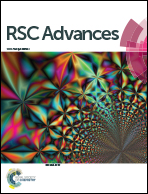Effect of double tailed cationic surfactants on the physicochemical behavior of hybrid vesicles†
Abstract
Hybrid vesicles, prepared from soy phosphatidylcholine (SPC), ion pair amphiphile (IPA), cholesterol (CHOL) and dihexadecyldimethylammmonium bromide (DHDAB), were investigated to assess their potential as novel drug delivery systems for indomethacin (IMC), a nonsteroidal anti inflammatory drug (NSAID). The size, polydispersity index and zeta potential values of the vesicles were monitored with respect to time using dynamic light scattering (DLS) measurements which confirmed the profound effect of both DHDAB and the drug. Incorporation of DHDAB, although resulting in the size enhancement of the liposome, however, enhanced vesicle stability induced by electrostatic repulsion. Both conventional and freeze-fractured transmission electron microscopic (TEM) studies revealed the spherical morphology of the vesicles. FTIR studies confirmed perceptible interaction among the drug and the lipid–surfactant mixtures. Thermal behavior of the vesicles was assessed by means of differential scanning calorimetric (DSC) studies in order to understand the interaction between the incorporated NSAID and lipids. The state of polarity of IMC and another fluorescent molecular probe (7-hydroxycoumarin) were examined via absorption and emission spectroscopy respectively. Results on the fluorescence anisotropy studies helped in understanding the head group packing of the amphiphiles in the vesicles. An in vitro release study of the NSAID from vesicles revealed that incorporation of DHDAB promoted the release of the drug. Among different proposed models, the Korsmeyer–Peppas model was found to be the best one and the release mechanism was predominantly Fickian diffusion. The formulations, in the absence and presence of IMC showed no cytotoxicity in healthy human blood cell lymphocyte as well as in the human breast adenocarcinoma cell line (MCF 7). The aforementioned studies provided deeper insight into the interaction pattern of DHDAB with hybrid vesicles thereby exploring the usefulness of such systems as effective drug carriers.


 Please wait while we load your content...
Please wait while we load your content...